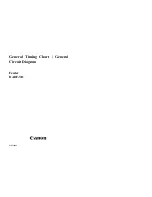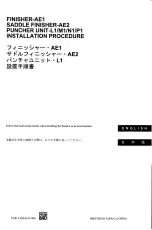
3. Potential Detecting Circuit
Figure 3-303 is a block diagram of the poten-
tial detecting circuit.
Charges corresponding to the drum surface
potential are induced on the electrode inside the
sensor and are turned into AC voltage by the
opening/closing of the chopper and sent to the
pre-amplifier circuit; the voltage is amplified by the
pre-amplifier circuit and then sent to the filter/gain
adjustment circuit on the surface potential mea-
surement PCB.
Figure 3-302
The filter/gain adjustment circuit removes elec-
trical noise from the AC signal coming from the
pre-amplifier circuit, and it further amplifies AC
signal and sends it to the sync clamp circuit.
The sync clamp circuit combines the AC signal
from the filter/gain adjustment circuit and the sync
signal from the sync adjustment circuit to identify
whether the drum surface potential is positive or
negative.
Figure 3-304 Surface Potential Higher Than
the Sensor Bias
Reference:
The letter F of F30V stands for “floating,”
indicating that the reference line of the
power supply is not grounded, i.e., not 0 V.
3. OPERATIONS AND TIMING
COPYRIGHT © 1996 CANON INC.
CANON NP6085 REV.0 JULY 1996 PRINTED IN JAPAN (IMPRIME AU JAPON)
3-53
Sensor cover
Electrode
Chopper
2.5 mm (approx.)
--
+
--
Signal from
sensor
Sync signal
Sync clamp
circuit output
V
x
+12V
Chopper
Electrode
Piezoelectric oscillator
Potential sensor
Photo-
coupler
Transformer
circuit (1/300)
DC controller PCB
Level shift circuit
Pre-
amplifier
circuit
Filter/gain
adjustment
Oscillation
Level shift
circuit
Micro-
processor
Sync
signal
adjustment
Transformer
(1/300)
Sync
clamp
Integration/
differential
amplification
DC
transformer
F30V
Photo-
coupler
LED1
CP101-7
J132
-1
-2
POTON
POT
Figure 3-303
















































